Ultra-High Sensitivity Ultrasonic Sensor with an Extrinsic All-Polymer Cavity
Abstract
1. Introduction
2. Principle of the Sensor
3. Experimental Result and Discussions
4. Conclusions
Author Contributions
Funding
Institutional Review Board Statement
Informed Consent Statement
Data Availability Statement
Conflicts of Interest
References
- Wang, Y.; Yuan, H.; Liu, X.; Bai, Q.; Zhang, H.; Gao, Y.; Jin, B. A Comprehensive Study of Optical Fiber Acoustic Sensing. IEEE Access 2019, 7, 85821–85837. [Google Scholar] [CrossRef]
- Xiang, Z.; Dai, W.; Rao, W.; Cai, X.; Fu, H. A Gold Diaphragm-Based Fabry-Perot Interferometer with a Fiber-Optic Collimator for Acoustic Sensing. IEEE Sens. J. 2021, 21, 17882–17888. [Google Scholar] [CrossRef]
- Bucaro, J.A.; Dardy, H.D.; Carome, E.F. Fiber-optic hydrophone. J. Acoust. Soc. USA 1977, 62, 1302–1304. [Google Scholar] [CrossRef]
- Cole, J.H.; Johnson, R.L.; Bhuta, P.G. Fiber-optic detection of sound. J. Acoust. Soc. USA 1977, 62, 1136–1138. [Google Scholar] [CrossRef]
- Dong, B.; Zhang, B.H.; Ng, J.H.; Wang, Y.X.; Yu, C.Y. Ultrahigh-Sensitivity Fiber Acoustic Sensor with a Dual Cladding Modes Fiber Up-Taper Interferometer. IEEE Photonics Technol. Lett. 2015, 27, 2234–2237. [Google Scholar] [CrossRef]
- Liu, B.; Lin, J.; Liu, H.; Ma, Y.; Yan, L.; Jin, P. Diaphragm based long cavity Fabry–Perot fiber acoustic sensor using phase generated carrier. Opt. Commun. 2017, 382, 514–518. [Google Scholar] [CrossRef]
- Fan, H.; Zhang, L.; Gao, S.; Chen, L.; Bao, X. Ultrasound sensing based on an in-fiber dual-cavity Fabry–Perot interferometer. Opt. Lett. 2019, 44, 3606–3609. [Google Scholar] [CrossRef]
- Liu, X.; Gang, T.; Tong, R.; Qiao, X.; Zuo, C.; Bai, X.; Bian, C.; Hu, M. Air-coupled fiber Fabry-Perot ultrasonic sensor formed by diaphragm for seismic physical model imaging. Optik 2018, 168, 794–799. [Google Scholar] [CrossRef]
- Li, C.; Peng, X.; Zhang, H.; Wang, C.; Fan, S.; Cao, S. A sensitivity-enhanced flexible acoustic sensor using side-polished fiber Bragg grating. Measurement 2018, 117, 252–257. [Google Scholar] [CrossRef]
- Campopiano, S.; Cutolo, A.; Cusano, A.; Giordano, M.; Parente, G.; Lanza, G.; Laudati, A. Underwater acoustic sensors based on fiber Bragg gratings. Sensors 2009, 9, 4446–4454. [Google Scholar] [CrossRef]
- Fomitchov, P.A.; Krishnaswamy, S. Response of a fiber Bragg grating ultrasonic sensor. Opt. Eng. 2003, 42, 956–963. [Google Scholar] [CrossRef]
- Liang, G.; Jiang, J.; Liu, K.; Wang, S.; Xu, T.; Chen, W.; Ma, Z.; Ding, Z.; Zhang, X.; Zhang, Y. Phase demodulation method based on a dual-identical-chirped-pulse and weak fiber Bragg gratings for quasi-distributed acoustic sensing. Photon. Res. 2020, 8, 1093–1099. [Google Scholar] [CrossRef]
- Vidakovic, M.; McCague, C.; Armakolas, I.; Sun, T.; Carlton, J.S.; Grattan, K.T. Fibre Bragg grating-based cascaded acoustic sensors for potential marine structural condition monitoring. J. Lightwave Technol. 2016, 34, 4473–4478. [Google Scholar] [CrossRef]
- Gang, T.; Hu, M.; Qiao, X.; Li, J.; Shao, Z.; Tong, R.; Rong, Q. Fiber-optic Michelson interferometer fixed in a tilted tube for direction-dependent ultrasonic detection. Opt. Lasers Eng. 2017, 88, 60–64. [Google Scholar] [CrossRef]
- Fan, P.; Yan, W.; Lu, P.; Zhang, W.; Zhang, W.; Fu, X.; Zhang, J. High sensitivity fiber-optic Michelson interferometric low-frequency acoustic sensor based on a gold diaphragm. Opt. Express 2020, 28, 25238–25249. [Google Scholar] [CrossRef]
- Liu, L.; Lu, P.; Liao, H.; Wang, S.; Yang, W.; Liu, D.; Zhang, J. Fiber-optic michelson interferometric acoustic sensor based on a PP/PET diaphragm. IEEE Sens. J. 2016, 16, 3054–3058. [Google Scholar] [CrossRef]
- Lan, C.; Zhou, W.; Xie, Y. Detection of Ultrasonic Stress Waves in Structures Using 3D Shaped Optic Fiber Based on a Mach–Zehnder Interferometer. Sensors 2018, 18, 1218. [Google Scholar] [CrossRef]
- Ouyang, B.; Li, Y.; Kruidhof, M.; Horsten, R.; van Dongen, K.W.; Caro, J. On-chip silicon Mach–Zehnder interferometer sensor for ultrasound detection. Opt. Lett. 2019, 44, 1928–1931. [Google Scholar] [CrossRef]
- Peternella, F.G.; Ouyang, B.; Horsten, R.; Haverdings, M.; Kat, P.; Caro, J. Interrogation of a ring-resonator ultrasound sensor using a fiber Mach-Zehnder interferometer. Opt. Express 2017, 25, 31622–31639. [Google Scholar] [CrossRef]
- Rivera, J.L.; Sánchez, M.P.; Miridonov, A.; Stepanov, S. Adaptive Sagnac interferometer with dynamic population grating in saturable rare-earth-doped fiber. Opt. Express 2013, 21, 4280–4290. [Google Scholar] [CrossRef]
- Hu, S.; Dong, B.; Yu, K.; Zhou, J.; Wang, L. A hydrophone based on high-birefringence fiber loop mirror. SPIE 2010, 7659, 197–202. [Google Scholar]
- Liu, B.; Zhou, H.; Liu, L.; Wang, X.; Shan, M.; Jin, P.; Zhong, Z. An Optical Fiber Fabry-Perot Microphone Based on Corrugated Silver Diaphragm. IEEE Trans. Instrum. Meas. 2018, 67, 1994–2000. [Google Scholar] [CrossRef]
- Wang, J.; Zhao, J.; Wang, J.; Wan, H.; Zhang, Z. A multi-frequency fiber optic acoustic sensor based on graphene-oxide Fabry-Perot microcavity. Opt. Fiber Technol. 2021, 65, 102607. [Google Scholar] [CrossRef]
- Gang, T.; Zuo, C.; Liu, X.; Bai, X.; Hu, M. High-sensitive ultrasonic sensor using fiber-tip PVC diaphragm Fabry-Perot interferometer and its imaging application. Sens. Actuators A Phys. 2018, 279, 474–480. [Google Scholar] [CrossRef]
- Wang, M.; Liu, T.; Wu, Y.; Rao, Y. Highly Sensitive Optical Fiber Ultrasonic Sensor for Partial Discharge Detection. In Optical Fiber Sensors Conference 2020 Special Edition; Optica Publishing Group: Washington, DC, USA, 2020; p. W4.14. [Google Scholar]
- Wang, Z.; Gao, C.; Chen, Z.; Ren, W.; Xie, H.; Wang, W. A Novel EFPI Sensor for Ultrasonic Testing of Partial-Discharge in High-Voltage Electrical Equipment. IEEE Access 2021, 9, 163456–163460. [Google Scholar] [CrossRef]
- Qian, G.; Peng, Q.; Peng, H.; Wang, S.; Zhang, Z.; Lei, J. A Polyimide Diaphragm-Based Extrinsic Optical Fiber Fabry-Perot Acoustic Sensor for the Detection of High-Frequency Ultrasonic Signals in Transformer Oil. In 2020 IEEE International Conference on High Voltage Engineering and Application (ICHVE, Beijing); 2020; pp. 1–4. Available online: https://ieeexplore.ieee.org/abstract/document/9279504 (accessed on 8 August 2022).
- Yao, M.; Zhang, Y.; Ouyang, X.; Ping Zhang, A.; Tam, H.-Y.; Wai, P.K.A. Ultracompact optical fiber acoustic sensors based on a fiber-top spirally-suspended optomechanical microresonator. Opt. Lett. 2020, 45, 3516–3519. [Google Scholar] [CrossRef]
- Yin, X.; Shen, Y.; Su, D.; Shao, Z. High-spatial-resolution ultrasonic sensor using a fiber-optic Fabry–Perot interferometer. Opt. Commun. 2019, 453, 124422. [Google Scholar] [CrossRef]
- Si, W.; Fu, C.; Wu, X.; Lu, Q.; He, L.; Yuan, P. Study on the fiber optic EFPI ultrasonic transducer with a beam-supported membrane structure for PD measurement. In 2019 IEEE Sustainable Power and Energy Conference (iSPEC, Beijing); 2019; pp. 2856–2859. Available online: https://ieeexplore.ieee.org/abstract/document/8975217 (accessed on 8 August 2022).
- Wang, W. Fabry-Perot Interference Fiber Acoustic Wave Sensor Based on Laser Welding All-Silica Glass. Materials 2022, 15, 2484. [Google Scholar] [CrossRef]
- Xiao, M.; Yin, S.; Xie, S.; Zhou, C.; Tian, J.; Yao, Y. All-Fiber Ultrasonic Sensor Based On Ultrathin Silica Reflective Diaphragm. In Proceedings of the 2019 18th International Conference on Optical Communications and Networks (ICOCN, Huangshan), Huangshan, China, 5–8 August 2019; pp. 1–3. [Google Scholar]
- Gong, Z.; Chen, K.; Zhou, X.; Yang, Y.; Zhao, Z.; Zou, H.; Yu, Q. High-Sensitivity Fabry-Perot Interferometric Acoustic Sensor for Low-Frequency Acoustic Pressure Detections. J. Lightwave Technol. 2017, 35, 5276–5279. [Google Scholar] [CrossRef]
- Heming, W.; Sridhar, K. Femtosecond laser fabricated Fabry-Perot sensors on optical fiber tip for acoustic sensor. SPIE 2019, 10972, 265–271. [Google Scholar]
- Ma, J.; Xuan, H.; Ho, H.L.; Jin, W.; Yang, Y.; Fan, S. Fiber-Optic Fabry–Pérot Acoustic Sensor With Multilayer Graphene Diaphragm. IEEE Photonics Technol. Lett. 2013, 25, 932–935. [Google Scholar] [CrossRef]
- Gong, Z.; Chen, K.; Yang, Y.; Zhou, X.; Peng, W.; Yu, Q. High-sensitivity fiber-optic acoustic sensor for photoacoustic spectroscopy based traces gas detection. Sens. Actuators B Chem. 2017, 247, 290–295. [Google Scholar] [CrossRef]
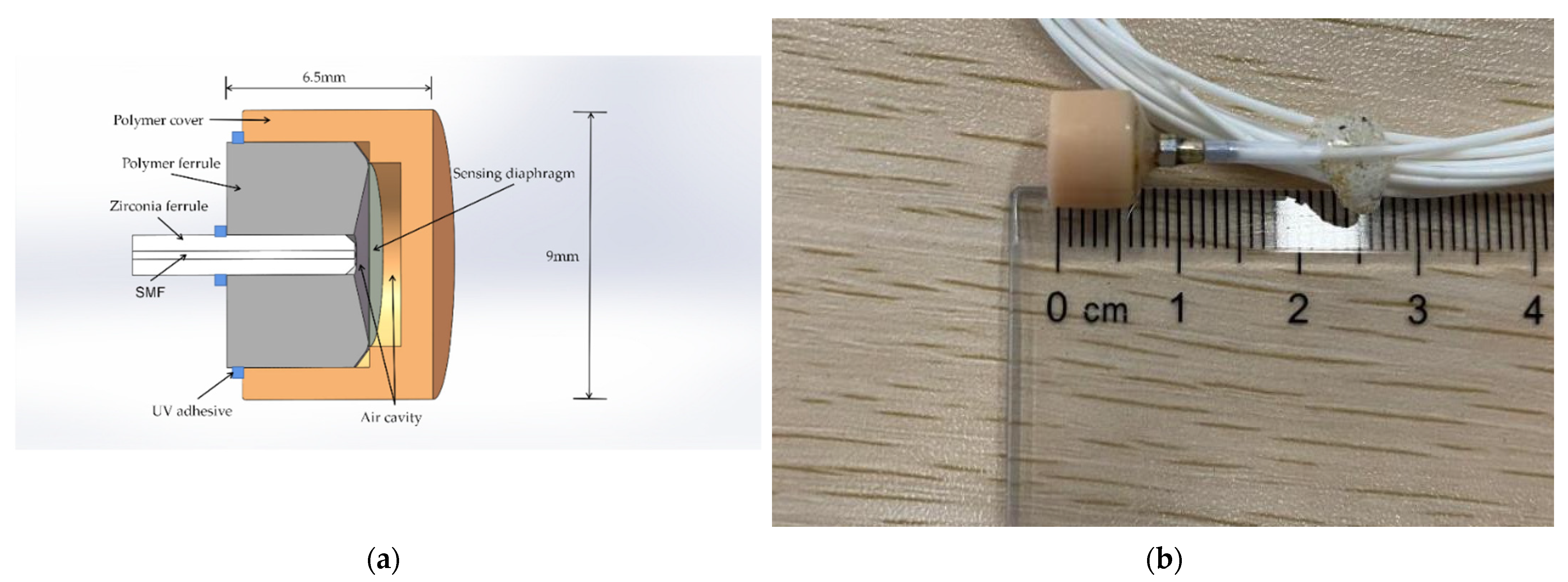
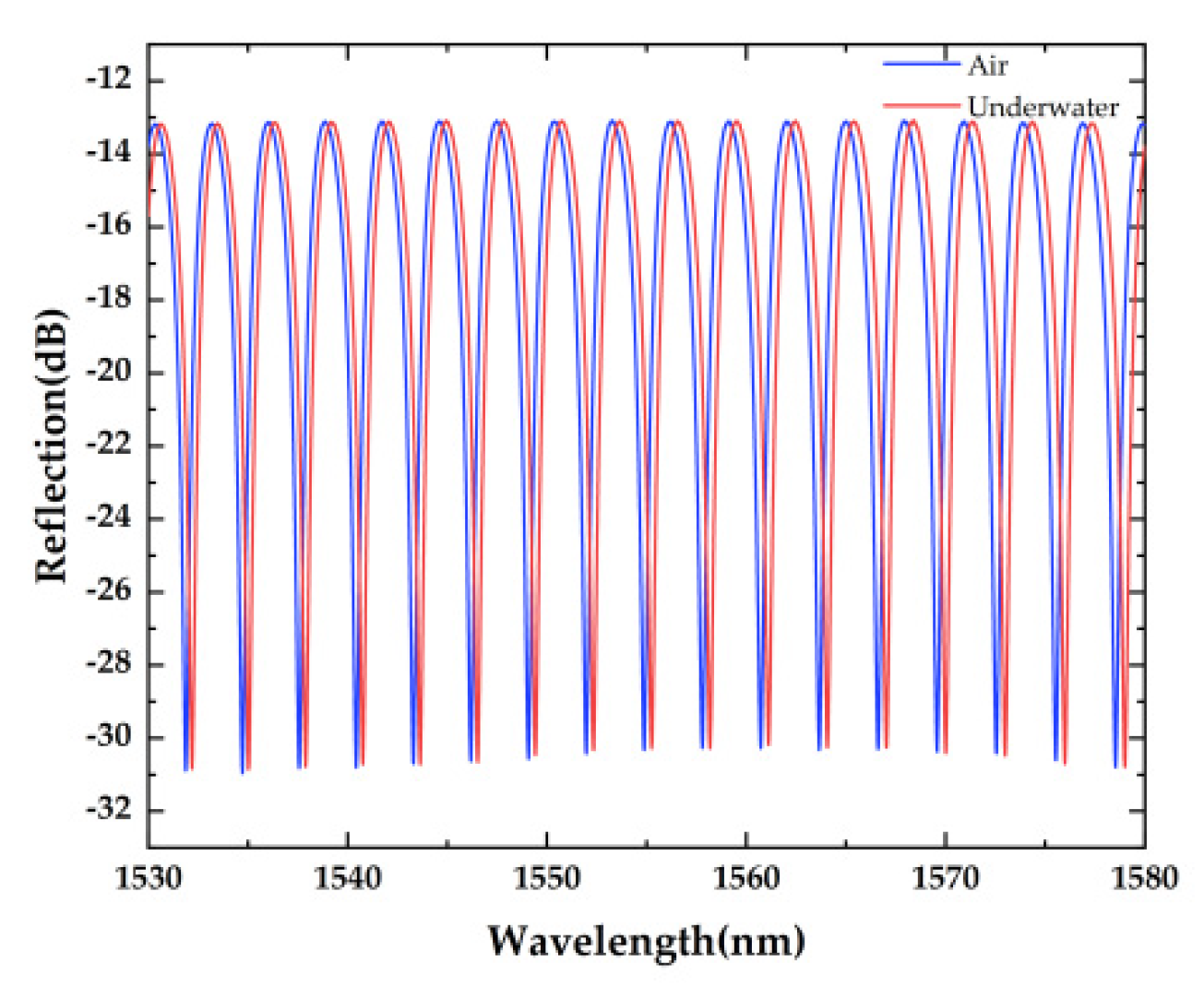

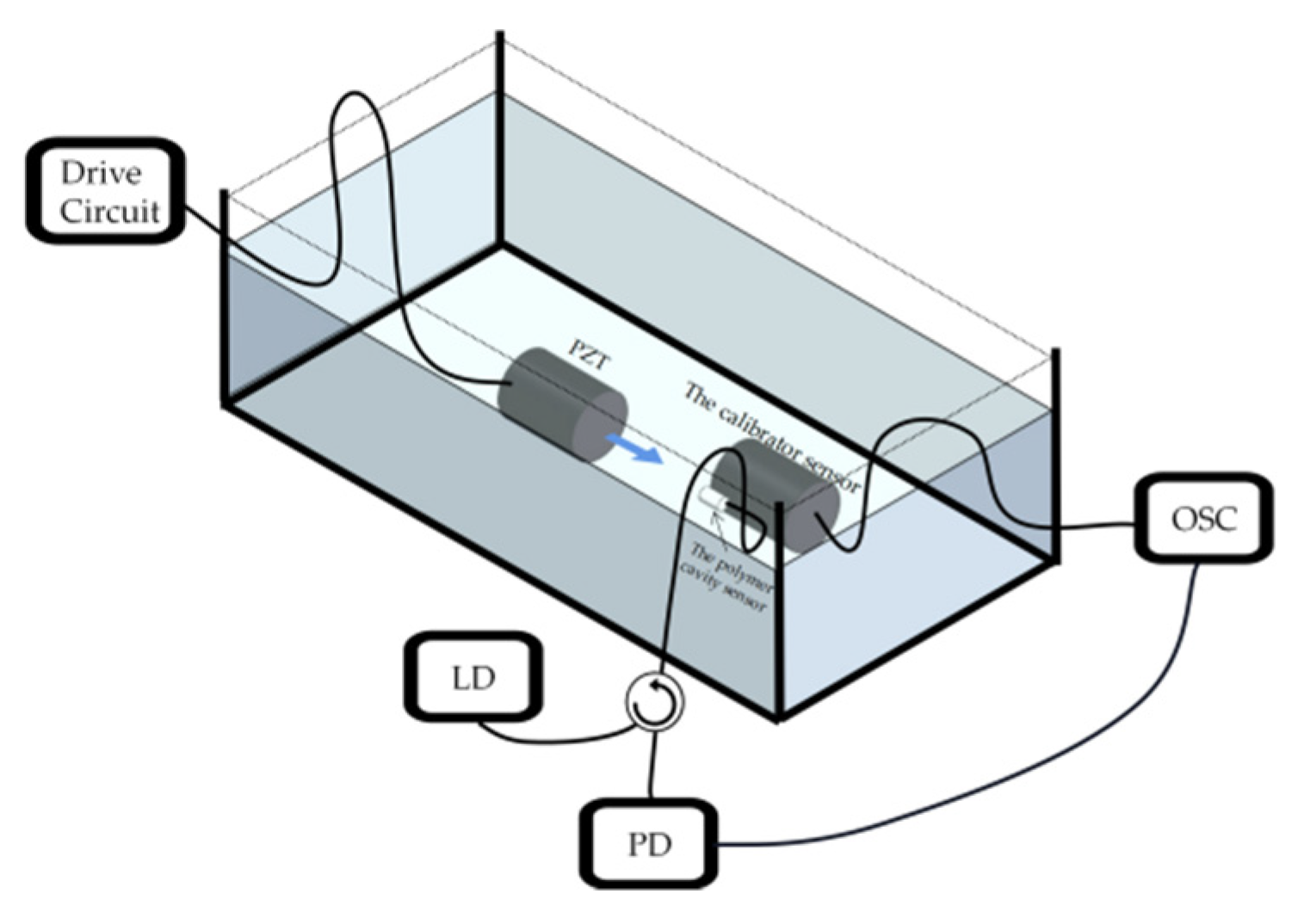

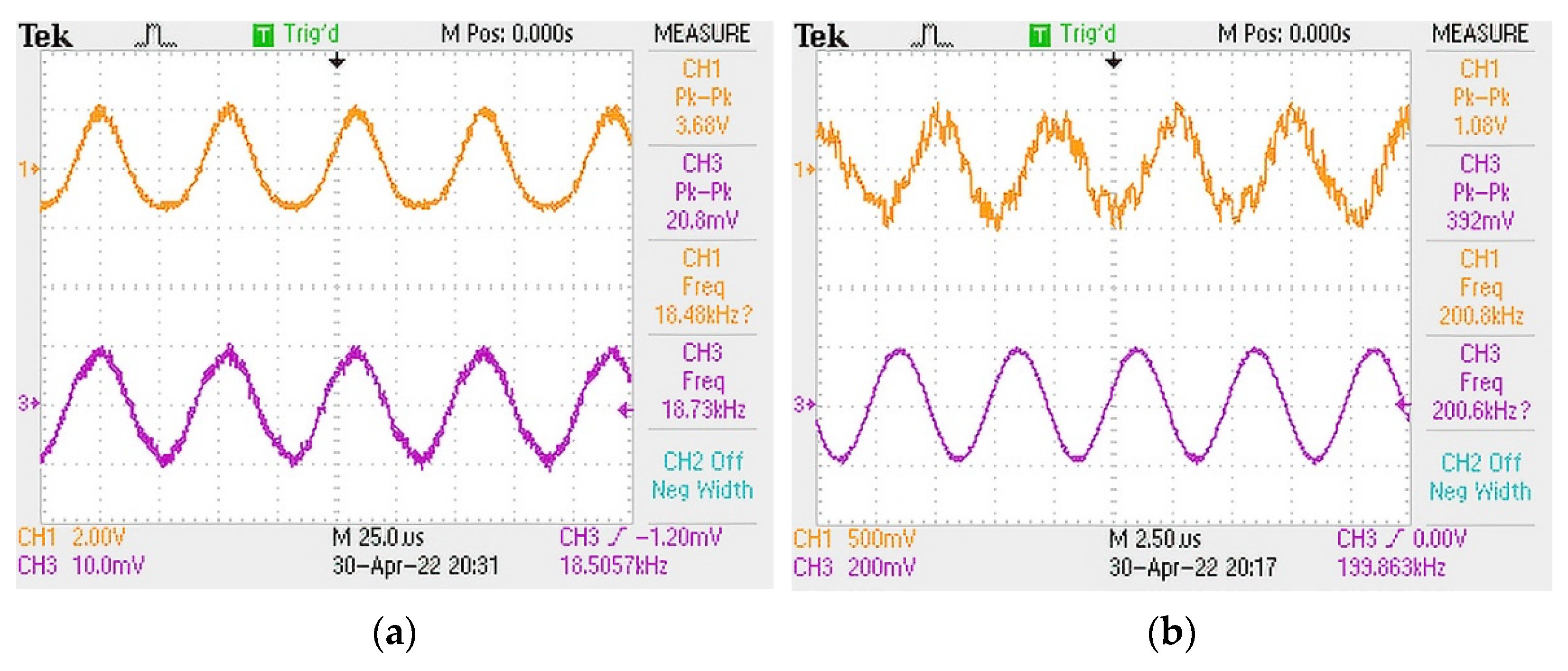
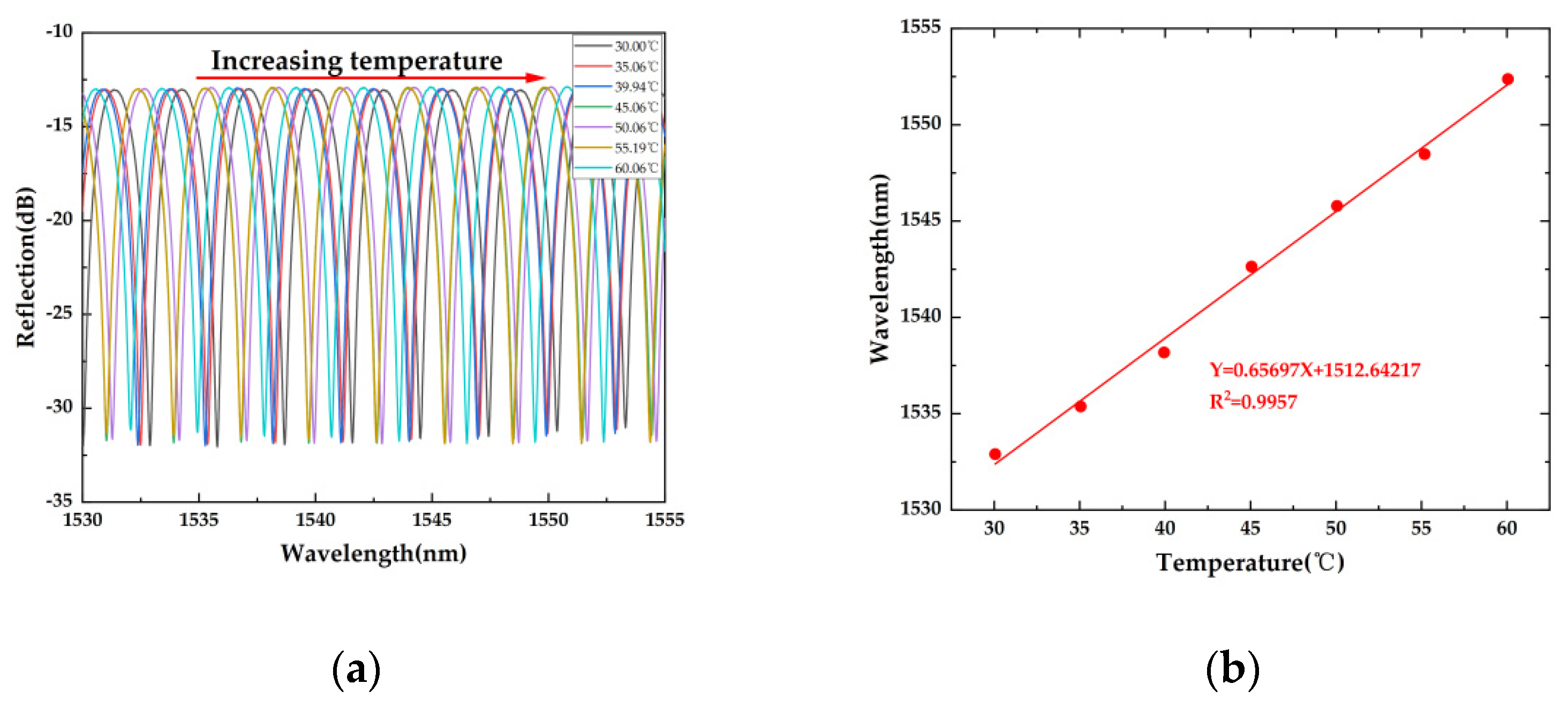
Publisher’s Note: MDPI stays neutral with regard to jurisdictional claims in published maps and institutional affiliations. |
© 2022 by the authors. Licensee MDPI, Basel, Switzerland. This article is an open access article distributed under the terms and conditions of the Creative Commons Attribution (CC BY) license (https://creativecommons.org/licenses/by/4.0/).
Share and Cite
Chen, Z.; Dong, B.; Huang, W.; Yi, Y.; Chan, C.; Ruan, S.; Hou, S. Ultra-High Sensitivity Ultrasonic Sensor with an Extrinsic All-Polymer Cavity. Sensors 2022, 22, 7069. https://doi.org/10.3390/s22187069
Chen Z, Dong B, Huang W, Yi Y, Chan C, Ruan S, Hou S. Ultra-High Sensitivity Ultrasonic Sensor with an Extrinsic All-Polymer Cavity. Sensors. 2022; 22(18):7069. https://doi.org/10.3390/s22187069
Chicago/Turabian StyleChen, Zongyu, Bo Dong, Wobin Huang, Yunji Yi, Chichiu Chan, Shuangchen Ruan, and Shaoyu Hou. 2022. "Ultra-High Sensitivity Ultrasonic Sensor with an Extrinsic All-Polymer Cavity" Sensors 22, no. 18: 7069. https://doi.org/10.3390/s22187069
APA StyleChen, Z., Dong, B., Huang, W., Yi, Y., Chan, C., Ruan, S., & Hou, S. (2022). Ultra-High Sensitivity Ultrasonic Sensor with an Extrinsic All-Polymer Cavity. Sensors, 22(18), 7069. https://doi.org/10.3390/s22187069





